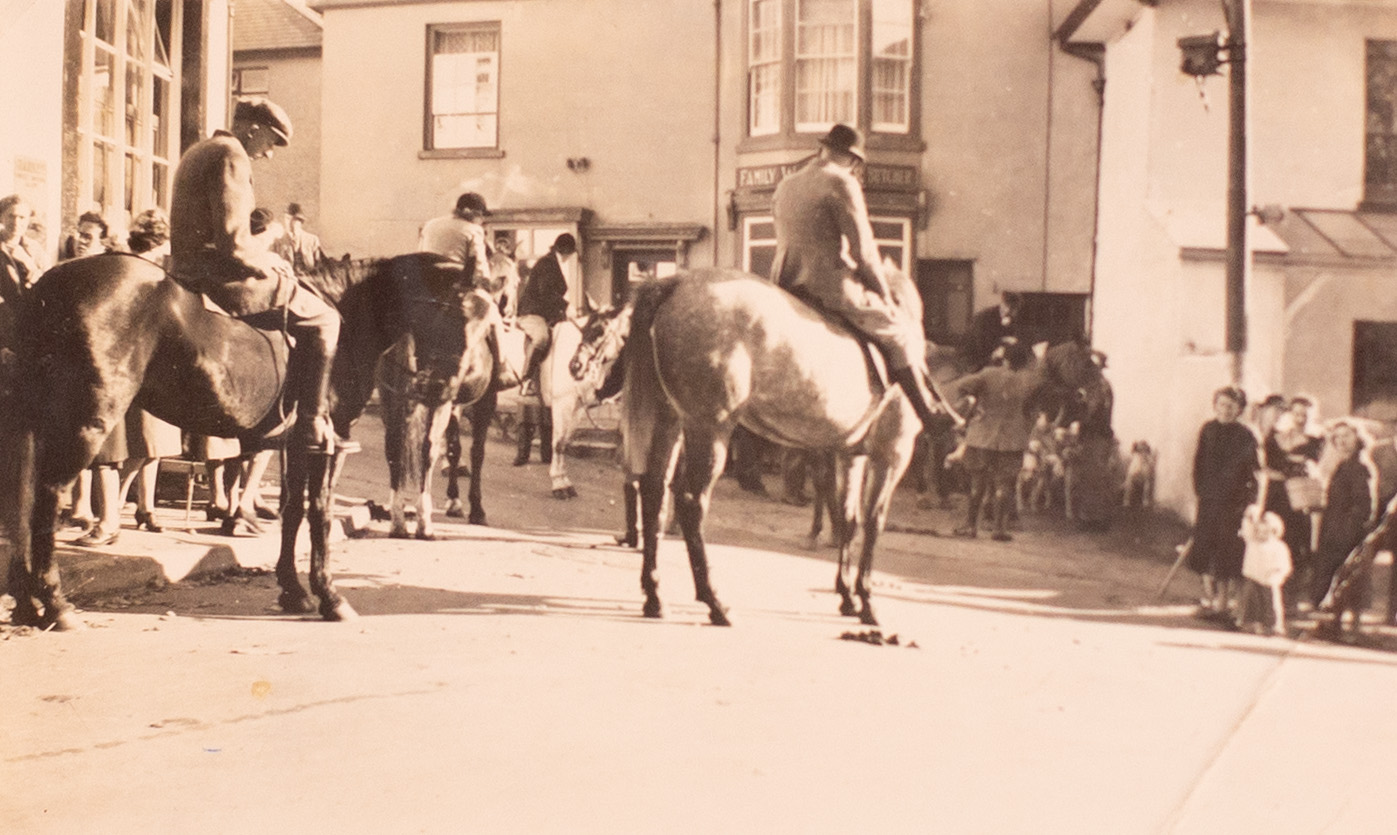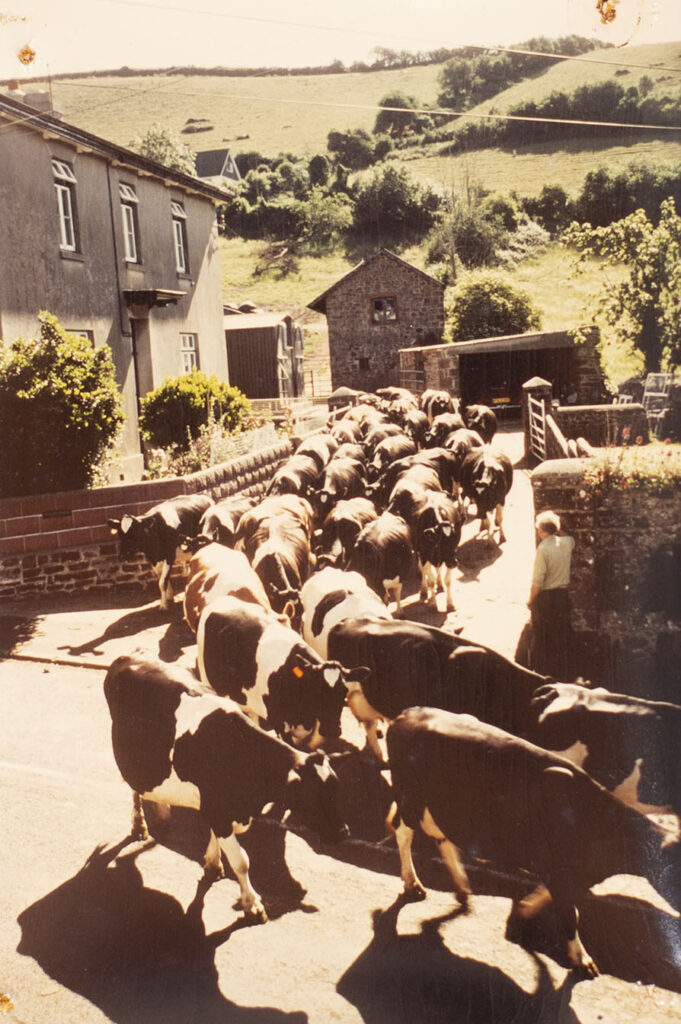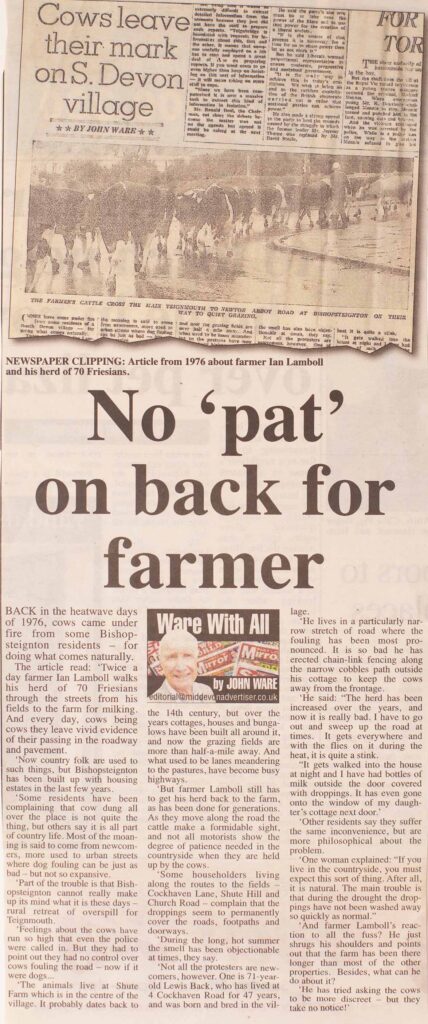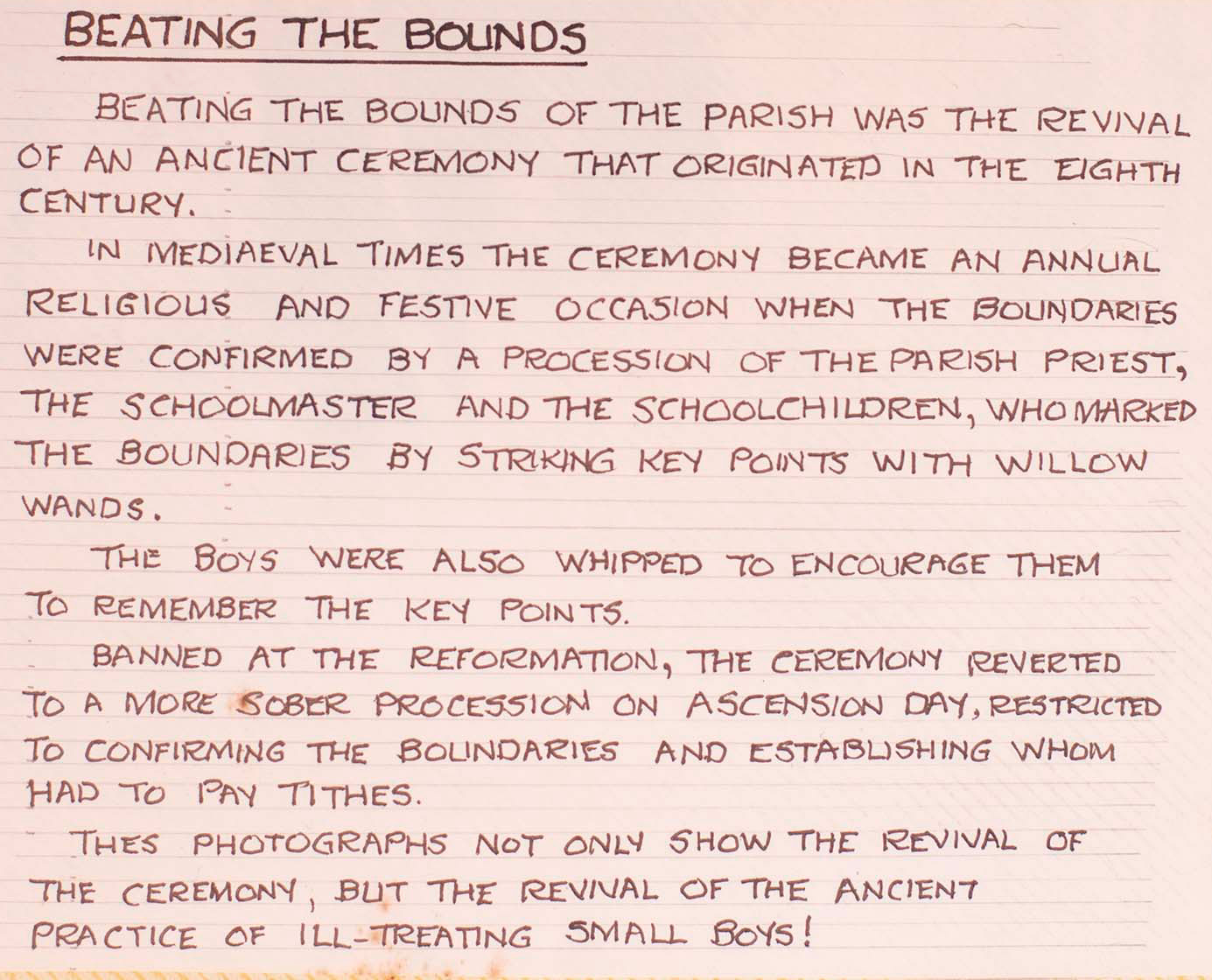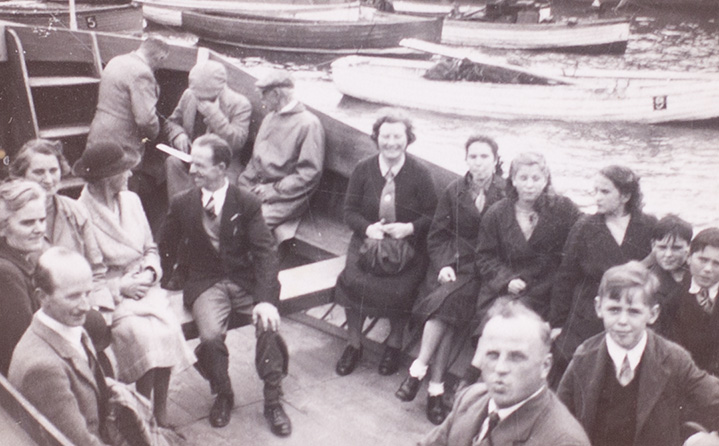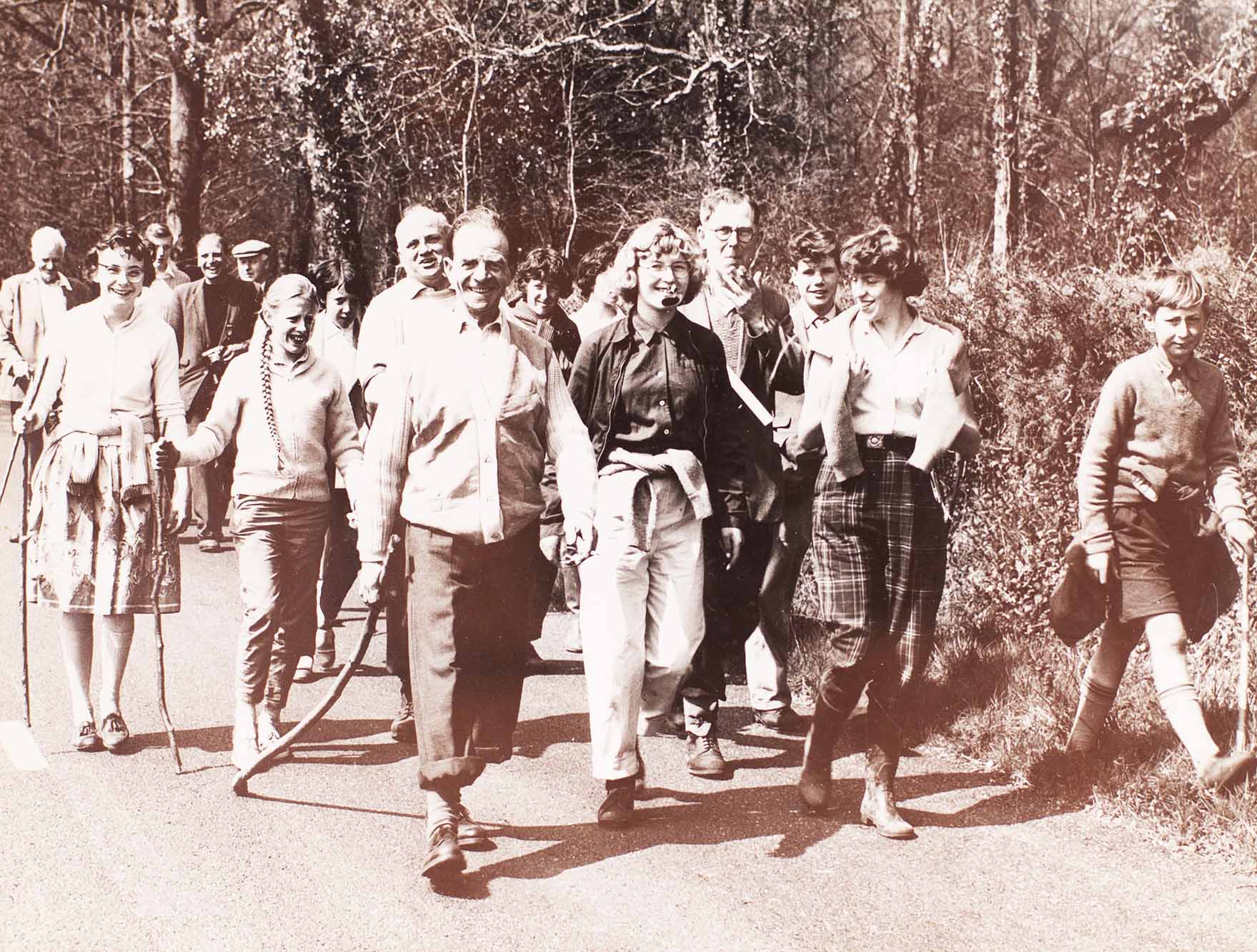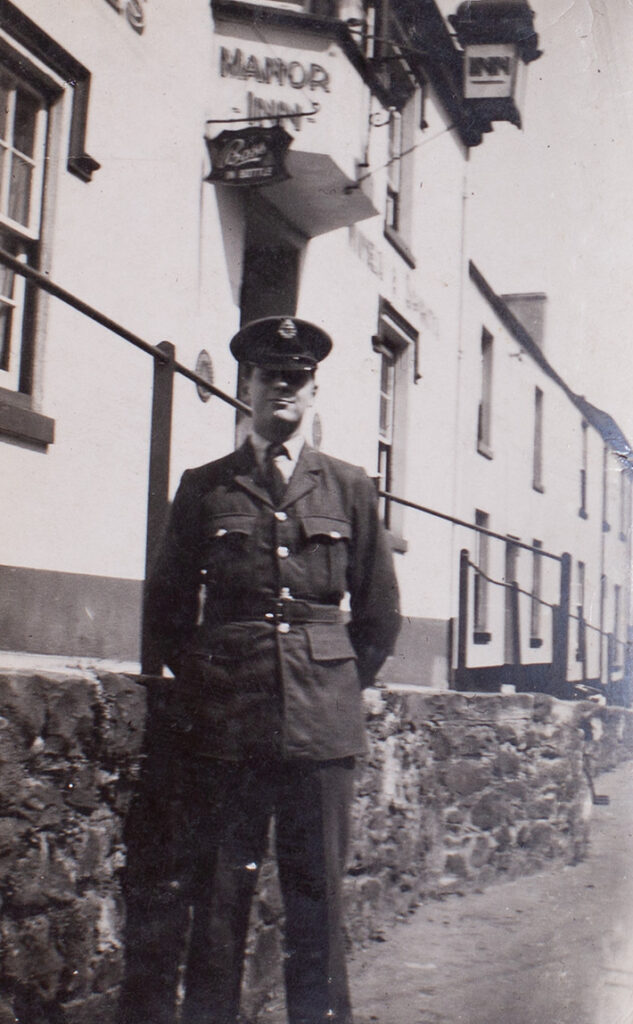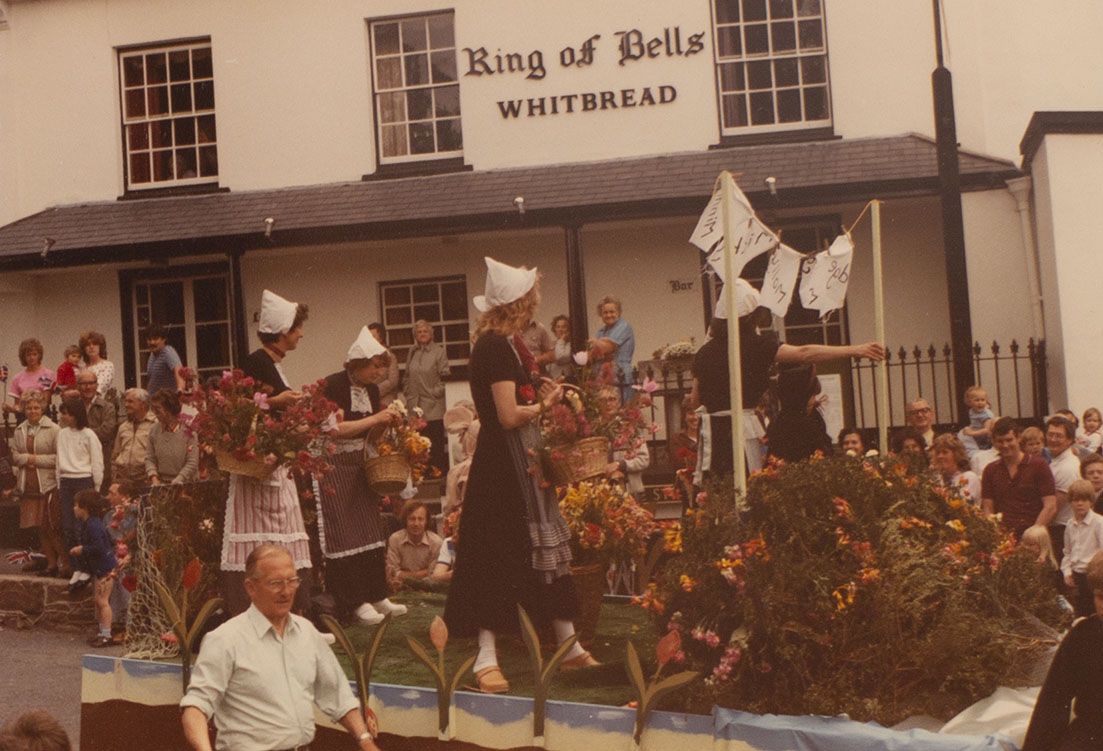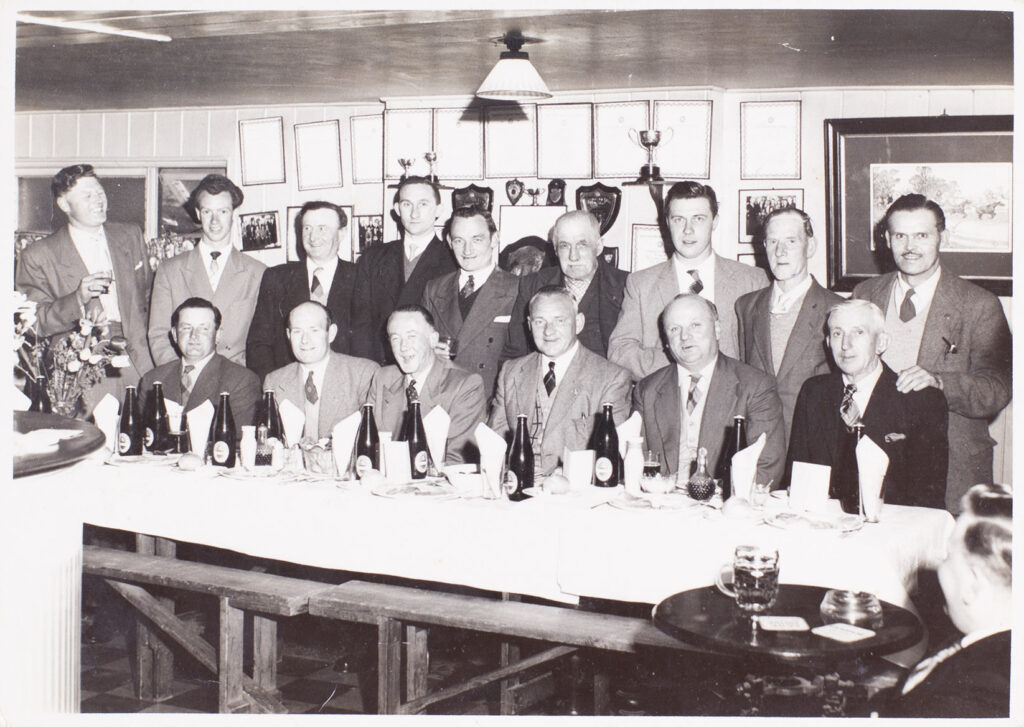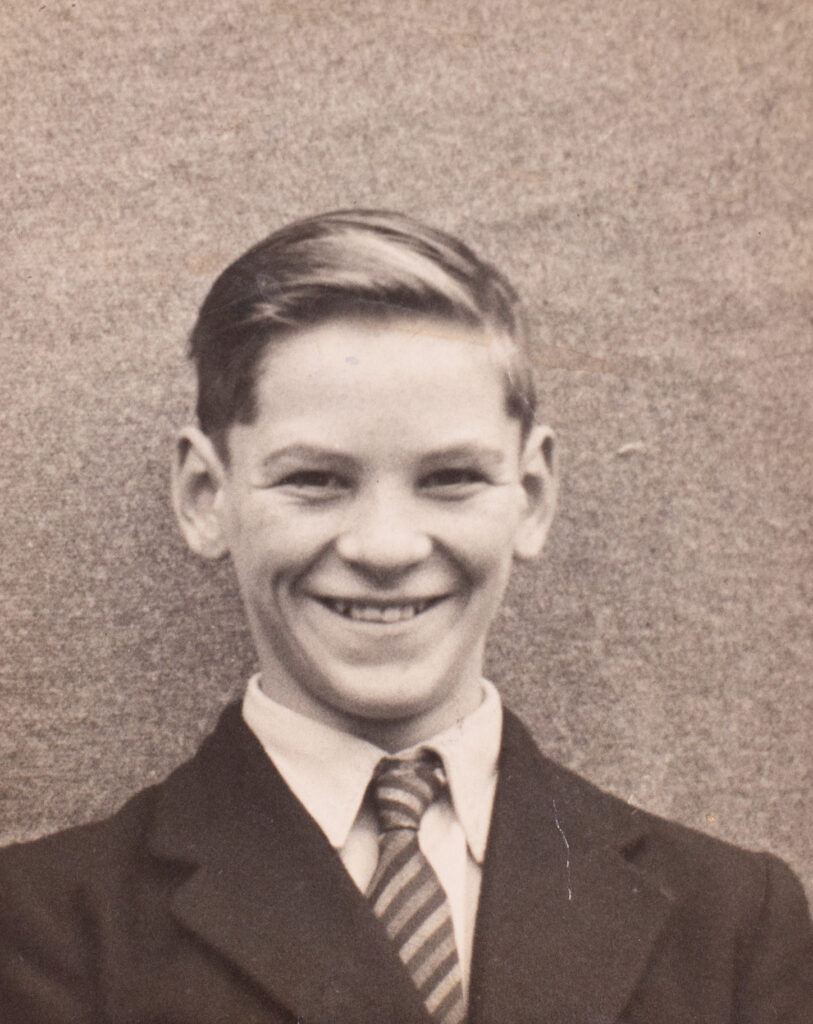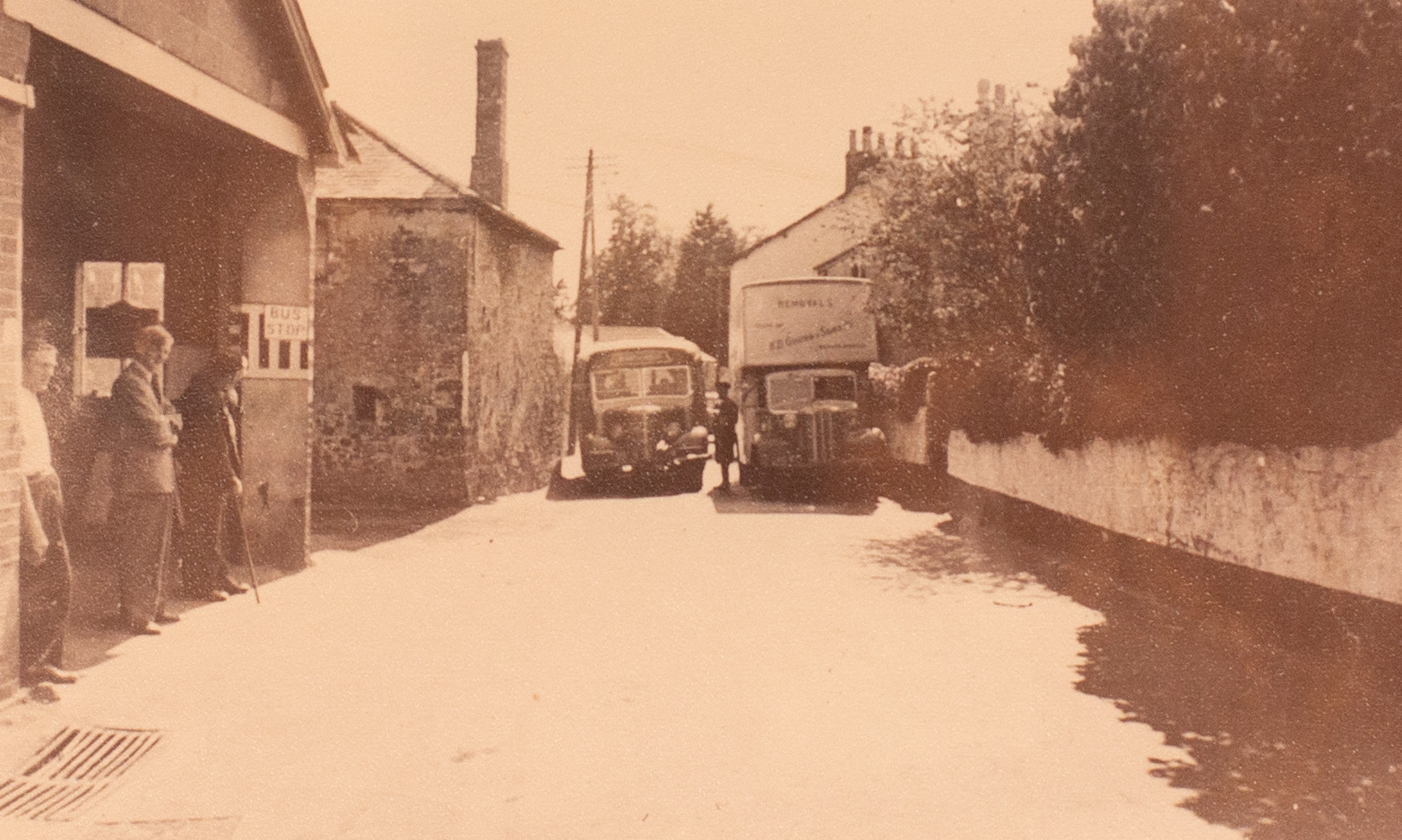The meeting of the hounds; was quite a sight. The horses, riders and dogs met outside the ‘Ring of Bells’. When Farmer Isaac from Cockhaven Farm rode up, the pack of hounds were released from the lorry. It was quite a sight with all the dogs running around yet seemingly very well behaved. Farmer Isaac’s horse, which I believe was a ‘hunter’, appeared to be enormous, with farmer Isaac, a big chap on top, they seemed to dwarf everything. The stirrup cup drunk, the hunting horn blown and off they went, up through Fore St. and Clanage St. up Smith Hill and away into the country. This just left some young lads with buckets and spades to collect the horse droppings. A valuable asset for dads growing rhubarb and roses. Cliff who worked for Farmer Lamboll of Shute Farm always brought up the rear riding a not so highbred steed. He once rode it without a saddle but kept up with the hunt.
Farmer Lamboll brought his cows in for milking from Coles Barn to Shute Farm opposite the school twice a day and of course after milking had to return them to the field. We were never tired of watching them amble up through the road. They did not seem to care if they were holding up a Rolls Royce an Austin 7 or the local bus service. They were in no hurry and there were always some juicy tit bits hanging over walls. Over the years, we got to recognise some of them. One cow in particular that stands out in my memory had an extremely large udder, almost to the floor. I felt sorry for her, as she had to carry that about all day. She had a lovely face and seemed to smile as she went by gently making her way up and down the road, silly really but I am sure at times, she recognised us!
‘Beating of the Bounds’ created quite a lot of interest, with many of the villagers walking the whole of the boundary of the parish. Rev. Ingram walked it each time to give a blessing at certain points where it was thought the mile or boundary stones would have originally been. The youngest child was, given a couple of ‘bumps’ at these points. I only did part of the walk, once but my older and younger brother did the whole thing. One year, the Reverent Ingram was taken by rowing boat, out to the middle of the River Teign to give a blessing at that watery boundary.
The Reverent Ingram was not only a clergyman and local vicar but also a real gentleman. He must have had a great respect for Bishopsteignton and its people. From the way he wrote and talked about the village, he must have had a real love for the place. Rev Ingram would give support and visit anyone who needed it whether they were from his congregation; were not church members or they belonged to other faiths, he made himself available if required. He seemed to be very aware of the upset that mothers were going through when their sons had to go off to do their national service. For many it suddenly brought back the war years.
I can remember my mum and Mrs Shambrook (then landlady of the Manor Inn), having a good cry as her son Steve and my eldest brother David left the village on the same day for their national service. David (Air Force) and Steve (Navy), they had been close friends almost since birth. Amazingly, they did meet up a couple of times during their service, once in Malta and again in Aden. For a while, food parcels were put together to send to them. Mum and Mrs Shambrook were convinced their boys would not be fed properly by the forces. Mum made fruitcakes as they would last better and Mrs Shambrook adding snacks, biscuits and sweets.
“Apparently, the parcels were always well received; with all the recruits sharing ‘parcels from home’.”
At harvest festival time, Rev. Ingram led the celebrations in church, which had been beautifully decorated with fruits flowers, vegetables and other local produce. We children would take our offerings to school and then down to the church where Rev Ingram was waiting to receive them. Ken Dawe’s mum would make a harvest sheaf of bread, which fascinated me. I am not sure who got to eat it at the end of the celebrations. The harvest produce, whilst in church was blessed. It was then delivered to the village elderly and anyone requiring help at the time. I loved the harvest music and hymns which were always jolly. During harvest festival week, some of the men would take a selection of vegetables, fruit and flowers they had grown to The Ring of Bells where an auction was held for charity. Rev. Ingram was usually the auctioneer.
Another charity item we took to school, once a year, were eggs for ‘Toc-H week’ these were collected and distributed to local hospitals.
Part of the social heart were the three pubs in the village, The Ring of Bells, The Manor Inn and The Commercial (Bishop John). Each had its own teams for men’s darts, ladies darts as well as for Euchre. On a Sunday morning or evening, the men might have a game of Euchre or dominos. Saturday evenings and Sundays the men were always dressed very smart with collar and tie when they went to their regular local. My dad’s was the Ring of Bells.
I can remember a couple of times when Morris Dancers visited outside the Commercial and some Christmas times hand bell ringers visited the Manor Inn. Each of the pubs supported local activities such as the football, Bishopsteignton players and other groups. It was no use trying to get a drink under age as the landlords and their customers all knew who we were. Each of the pubs had a jug and bottle where children (not allowed in the bars) could buy crisps (plain with a little bag of salt), lemonade etc. The Commercial was the only place to buy wagon wheels, the big chocolate and marshmallow biscuit in a waxy bag at 3d each.
My uncle, Lewis Back, for many years ran a ‘thrift club’ at the Commercial. One night a week, the customers could give what cash they wanted to save and he would record it, bank it and pay out the savings near Christmas. The saver was free to spend what they saved, on anything they fancied but it usually went on Christmas Fayre.
For trips to Teignmouth and Newton Abbot we had Gourds bus service, they had a garage and office in Radway Street. The drivers were always helpful to the ladies returning from town with loaded shopping bags. If their homes were on the bus route, the drivers would stop outside their homes and help them carry the shopping to the door.
When we were very young, going on the bus was like a day out. Sometimes we would go with mum to Teignmouth to shop at ‘Maypole’ to stock up on items too expensive in the village. It fascinated me in ‘Maypole’ as all one wall was ceramic tiles, which depicted a massive picture of cows in a field and mountains or hills in the background. I used to imagine it to be Austria. The smells in Maypole were incredible, bacon and ham being sliced, butter and cheese being cut from big blocks, coffee grinding, fresh bread. If we behaved while mum was shopping, Marjorie who worked behind the counter would give us a little bag of broken biscuits.
Just down the road was Doels outfitters, where mum bought our school uniforms. To keep three boys in uniforms was expensive, (one at Grammar school and two at the Secondary modern), so to cover the cost mum would arrange a ‘Provident cheque’ with Mrs Harris of Radway Hill. Mrs Harris would then call on a Saturday morning to collect repayments of a few shillings a week. Sometimes her granddaughter Antoinette MacDonald would be with her.
“I was twelve before getting my first long trousers.”
On a Saturday several people from Bishop including my mum, (auntie) Flo & (uncle) Bill Martin and Mr Apps from Radway street travelled by Gourds to Newton Abbot for a whist drive held at the Liberal Club. Dad would enjoy his evening meeting friends for a pint and game of Euchure at the Ring of Bells. My brother John and I went with mum.
Mrs Bailey and Joyce would often be on the same bus going to the ‘pictures’, there were three cinemas in Newton Abbot. A couple of times, when I was on my own, Mrs Bailey let me join them. The two films I remember well are seeing ‘Ben Hur’ and a few weeks later, the ‘Ten Commandments’ both starring Charlton Heston. Incredible.
If John and I had to wait around the whist drive, we would take books, crayons and cards. We had to be quiet while they were playing (all very serious). We learned to communicate during the few minutes when the players changed tables. We were allowed two ounces of sweets, which were bought from Jean Rollins who worked in a sweet kiosk in the market square. She would always ask if we had been good all week, if we said yes she would put an extra sweet in the bag.
We always said yes but we were sometimes worried that she might know we had been naughty as she lived just a few doors away from us in Bishopsteignton. When the whist was nearly over mum would give us some coppers to go to the fish and chip shop for two pence worth of chips and some scribblings, (batter bits form the fish). It was then home and straight to bed.
A special coach outing was when Duggie Gourd ran a coach trip from the village to ‘Salmon Leap’ in Dartmoor area to see the Salmon making their way up river and leaping over some of the boulder steps in the water. That in our imaginations was like going abroad. Sometimes Duggie would play his watering can for us, he said it was ‘Handel’s Water Music’, we were not convinced but hung on every note and he loved the applause.
Another special outing was a group of women from the village went to see David Whitfield at Exeter. A singer from the 50’s and 60’s. There seemed to be great excitement the next day as they recalled the evening. There was a lot of talk about women who were actually swooning in the aisles? But not from the village, well at least no one confessed to having swooned…
Colin’s reminiscences are continued in 7 more parts, visit Born and Raised in Bishopsteignton to read more.
Thank you to Colin Back for his stories and to him and Lynette Renton for the images.
This article was assembled by Dawn Rogers and the Bishopsteignton Heritage Hub team.
The meeting of the hounds; was quite a sight. The horses, riders and dogs met outside the ‘Ring of Bells’. When Farmer Isaac from Cockhaven Farm rode up, the pack of hounds were released from the lorry. It was quite a sight with all the dogs running around yet seemingly very well behaved. Farmer Isaac’s horse, which I believe was a ‘hunter’, appeared to be enormous, with farmer Isaac, a big chap on top, they seemed to dwarf everything. The stirrup cup drunk, the hunting horn blown and off they went, up through Fore St. and Clanage St. up Smith Hill and away into the country. This just left some young lads with buckets and spades to collect the horse droppings. A valuable asset for dads growing rhubarb and roses. Cliff who worked for Farmer Lamboll of Shute Farm always brought up the rear riding a not so highbred steed. He once rode it without a saddle but kept up with the hunt.
Farmer Lamboll brought his cows in for milking from Coles Barn to Shute Farm opposite the school twice a day and of course after milking had to return them to the field. We were never tired of watching them amble up through the road. They did not seem to care if they were holding up a Rolls Royce an Austin 7 or the local bus service. They were in no hurry and there were always some juicy tit bits hanging over walls. Over the years, we got to recognise some of them. One cow in particular that stands out in my memory had an extremely large udder, almost to the floor. I felt sorry for her, as she had to carry that about all day. She had a lovely face and seemed to smile as she went by gently making her way up and down the road, silly really but I am sure at times, she recognised us!
‘Beating of the Bounds’ created quite a lot of interest, with many of the villagers walking the whole of the boundary of the parish. Rev. Ingram walked it each time to give a blessing at certain points where it was thought the mile or boundary stones would have originally been. The youngest child was, given a couple of ‘bumps’ at these points. I only did part of the walk, once but my older and younger brother did the whole thing. One year, the Reverent Ingram was taken by rowing boat, out to the middle of the River Teign to give a blessing at that watery boundary.
The Reverent Ingram was not only a clergyman and local vicar but also a real gentleman. He must have had a great respect for Bishopsteignton and its people. From the way he wrote and talked about the village, he must have had a real love for the place. Rev Ingram would give support and visit anyone who needed it whether they were from his congregation; were not church members or they belonged to other faiths, he made himself available if required. He seemed to be very aware of the upset that mothers were going through when their sons had to go off to do their national service. For many it suddenly brought back the war years.
I can remember my mum and Mrs Shambrook (then landlady of the Manor Inn), having a good cry as her son Steve and my eldest brother David left the village on the same day for their national service. David (Air Force) and Steve (Navy), they had been close friends almost since birth. Amazingly, they did meet up a couple of times during their service, once in Malta and again in Aden. For a while, food parcels were put together to send to them. Mum and Mrs Shambrook were convinced their boys would not be fed properly by the forces. Mum made fruitcakes as they would last better and Mrs Shambrook adding snacks, biscuits and sweets.
“Apparently, the parcels were always well received; with all the recruits sharing ‘parcels from home’.”
At harvest festival time, Rev. Ingram led the celebrations in church, which had been beautifully decorated with fruits flowers, vegetables and other local produce. We children would take our offerings to school and then down to the church where Rev Ingram was waiting to receive them. Ken Dawe’s mum would make a harvest sheaf of bread, which fascinated me. I am not sure who got to eat it at the end of the celebrations. The harvest produce, whilst in church was blessed. It was then delivered to the village elderly and anyone requiring help at the time. I loved the harvest music and hymns which were always jolly. During harvest festival week, some of the men would take a selection of vegetables, fruit and flowers they had grown to The Ring of Bells where an auction was held for charity. Rev. Ingram was usually the auctioneer. Another charity item we took to school, once a year, were eggs for ‘Toc-H week’ these were collected and distributed to local hospitals.
Part of the social heart were the three pubs in the village, The Ring of Bells, The Manor Inn and The Commercial (Bishop John). Each had its own teams for men’s darts, ladies darts as well as for Euchre. On a Sunday morning or evening, the men might have a game of Euchre or dominos. Saturday evenings and Sundays the men were always dressed very smart with collar and tie when they went to their regular local. My dad’s was the Ring of Bells.
I can remember a couple of times when Morris Dancers visited outside the Commercial and some Christmas times hand bell ringers visited the Manor Inn. Each of the pubs supported local activities such as the football, Bishopsteignton players and other groups. It was no use trying to get a drink under age as the landlords and their customers all knew who we were. Each of the pubs had a jug and bottle where children (not allowed in the bars) could buy crisps (plain with a little bag of salt), lemonade etc. The Commercial was the only place to buy wagon wheels, the big chocolate and marshmallow biscuit in a waxy bag at 3d each.
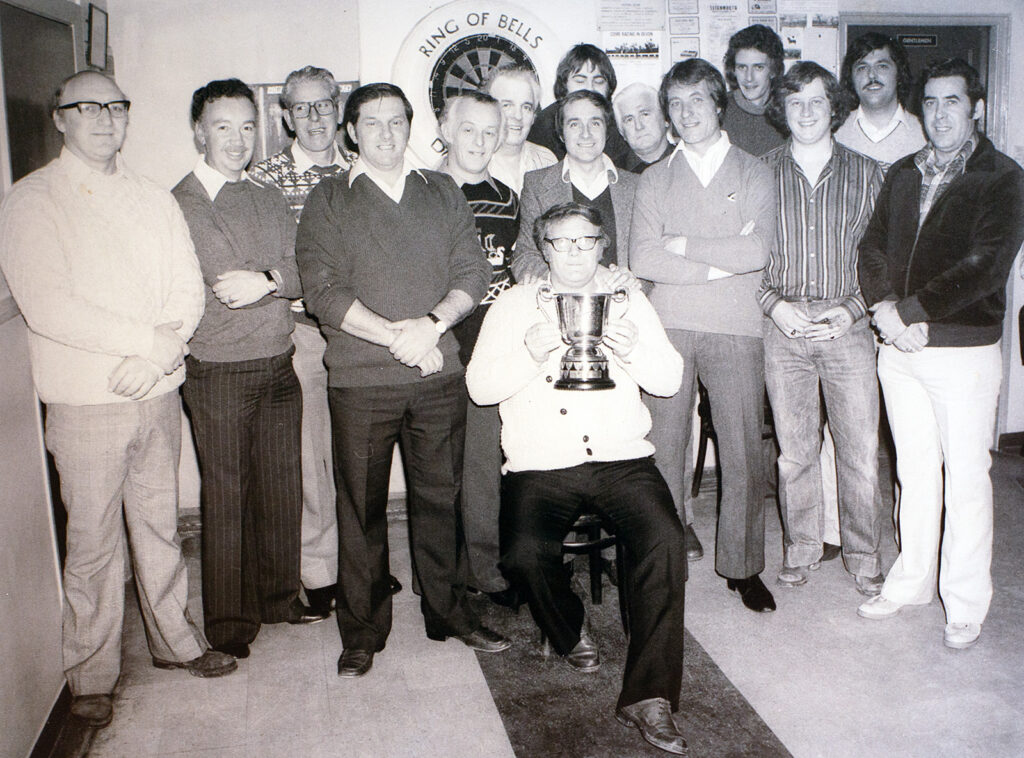
Ring of Bells Darts Team
My uncle, Lewis Back, for many years ran a ‘thrift club’ at the Commercial. One night a week, the customers could give what cash they wanted to save and he would record it, bank it and pay out the savings near Christmas. The saver was free to spend what they saved, on anything they fancied but it usually went on Christmas Fayre.
For trips to Teignmouth and Newton Abbot we had Gourds bus service, they had a garage and office in Radway Street. The drivers were always helpful to the ladies returning from town with loaded shopping bags. If their homes were on the bus route, the drivers would stop outside their homes and help them carry the shopping to the door.
When we were very young, going on the bus was like a day out. Sometimes we would go with mum to Teignmouth to shop at ‘Maypole’ to stock up on items too expensive in the village. It fascinated me in ‘Maypole’ as all one wall was ceramic tiles, which depicted a massive picture of cows in a field and mountains or hills in the background. I used to imagine it to be Austria. The smells in Maypole were incredible, bacon and ham being sliced, butter and cheese being cut from big blocks, coffee grinding, fresh bread. If we behaved while mum was shopping, Marjorie who worked behind the counter would give us a little bag of broken biscuits.
Just down the road was Doels outfitters, where mum bought our school uniforms. To keep three boys in uniforms was expensive, (one at Grammar school and two at the Secondary modern), so to cover the cost mum would arrange a ‘Provident cheque’ with Mrs Harris of Radway Hill. Mrs Harris would then call on a Saturday morning to collect repayments of a few shillings a week. Sometimes her granddaughter Antoinette MacDonald would be with her.
“I was twelve before getting my first long trousers.”
On a Saturday several people from Bishop including my mum, (auntie) Flo & (uncle) Bill Martin and Mr Apps from Radway street travelled by Gourds to Newton Abbot for a whist drive held at the Liberal Club. Dad would enjoy his evening meeting friends for a pint and game of Euchure at the Ring of Bells. My brother John and I went with mum.
Mrs Bailey and Joyce would often be on the same bus going to the ‘pictures’, there were three cinemas in Newton Abbot. A couple of times, when I was on my own, Mrs Bailey let me join them. The two films I remember well are seeing ‘Ben Hur’ and a few weeks later, the ‘Ten Commandments’ both starring Charlton Heston. Incredible.
If John and I had to wait around the whist drive, we would take books, crayons and cards. We had to be quiet while they were playing (all very serious). We learned to communicate during the few minutes when the players changed tables. We were allowed two ounces of sweets, which were bought from Jean Rollins who worked in a sweet kiosk in the market square. She would always ask if we had been good all week, if we said yes she would put an extra sweet in the bag.
We always said yes but we were sometimes worried that she might know we had been naughty as she lived just a few doors away from us in Bishopsteignton. When the whist was nearly over mum would give us some coppers to go to the fish and chip shop for two pence worth of chips and some scribblings, (batter bits form the fish). It was then home and straight to bed.
A special coach outing was when Duggie Gourd ran a coach trip from the village to ‘Salmon Leap’ in Dartmoor area to see the Salmon making their way up river and leaping over some of the boulder steps in the water. That in our imaginations was like going abroad. Sometimes Duggie would play his watering can for us, he said it was ‘Handel’s Water Music’, we were not convinced but hung on every note and he loved the applause.
Another special outing was a group of women from the village went to see David Whitfield at Exeter. A singer from the 50’s and 60’s. There seemed to be great excitement the next day as they recalled the evening. There was a lot of talk about women who were actually swooning in the aisles? But not from the village, well at least no one confessed to having swooned…
Colin’s reminiscences are continued in 7 more parts, visit Born and Raised in Bishopsteignton to read more.
Thank you to Colin Back for his stories and to him and, Lynette Renton for the images.
This article was assembled by Dawn Rogers and the Bishopsteignton Heritage Hub team.

